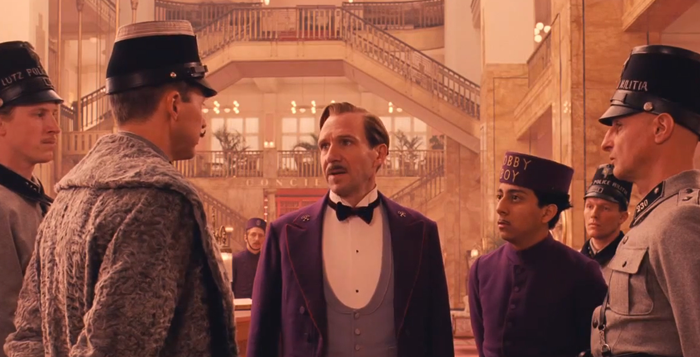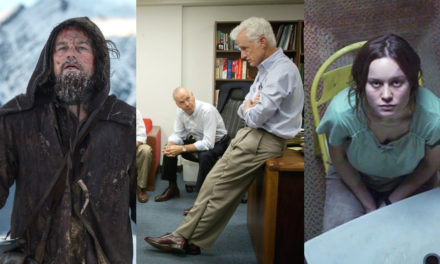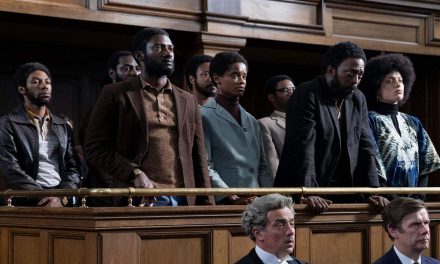
Courtesy of Scott Rudin Productions
Ralph Fiennes (center) stars in writer/director Wes Anderson’s latest effort “The Grand Budapest Hotel.” The film also features Tilda Swinton, Bill Murray, Jude Law, Adrien Brody and many more.
Wes Anderson has out Wes Anderson-ed himself.
It’s not to say that Anderson’s eighth feature “The Grand Budapest Hotel” will turn you sour to his mad scientist inventions of make-believe stirred up with violence and deceit and finished with gilded elaborateness and Pantone color schemes. But it might make you tired.
One watches an Anderson film as though one has received a pair of 3D glasses in the lobby. It’s hard not to want to reach out and touch the misted mountaintops or take a bite out of the rows of boxed Mendl’s courtesan au chocolats or push all of the buttons on the hotel’s elevators.
Anderson has a way with extreme wide and traveling shots as well as a strong attention to mise-en-scene that makes each frame a postcard. Call it over-particular or persnickety, but it’s all so clearly a product of what Anderson sees when he closes his eyes: dream stuff.
Set in a fictional eastern European spa town during the downtime between world wars, “Grand Budapest” tells the story of Monsieur Gustave H (Ralph Fiennes, “The English Patient”), a concierge of The Grand Budapest Hotel with an incredibly high opinion of himself and a taste for blonde, down-on-their-luck, wrinkled old maids.
Gustave soon hires Zero Moustafe (newcomer Tony Revolori) as a lobby boy, a kid with wide eyes and a drawn-on line of a mustache, who, for the entirety of the film, follows him around at a six-inch distance. Zero, we learn, is in love with the lovely and brilliant Agatha (Saoirse Ronan, “Atonement”), a pastry chef at the famous Mendl’s bakery who wears a birthmark on her right cheek in the shape of Mexico.
As soon as we feel like we’ve met the whole group, we find that Madame Céline Villeneuve Desgoffe und Taxis (Tilda Swinton, “Moonrise Kingdom”), the 84-year old widow countess who had been in love with Gustave, has been murdered just as Gustave and Zero steal celebrated Renaissance painting “Boy With Apple.” All of this triggers a breakout from any established homeostasis and results in a chase through the bleak and snowy countryside. Closely pursuing our protagonists are Inspector (Edward Norton, “Fight Club,” a buddy of Anderson’s), Dmitri (Adrien Brody, “The Pianist”) Madame D’s F-word abusing son and hitman Jopling (Willem Dafoe, “Spiderman”) who wears brass knuckles, all black and a shark-like smile.
In the spirit of all things Anderson, this story is told within another story. And that story is told within another story, making the guts of the narrative a product of not only Anderson’s imagination, but of the many characters telling it. The first frame is set up in the 1985 home of a seasoned writer (Tom Wilkinson, “Batman Begins”), who lives in a town called Old Lutz. The writer remembers 20 years earlier staying at the nearly deserted Grand Budapest Hotel and meeting Moustafa. We are then transported to the hotel in 1968 in what is referred to as the Alpine Republic of Zubrowka, where everything is faded and depressed from Cold War infection.
In this second framing device, the writer (now played by Jude Law, “Sherlock Holmes”) shares a thousand-course meal with Moustafa after meeting him in the Arabian bathhouse, and Moustafa recalls how it all started – back when the Grand Budapest was, as it suggests, grand.
Budapest is a visual spectacular with cinematography that cannot be contested. Anderson utilizes three different aspect ratios for the three different time periods. He employs unconventional cutting patterns in the dialogue-driven scenes. He even throws in some stop-motion animation to take us even further out of reality. Still, there’s something about this film that makes it hard to grip. This slipping feeling can partly be attributed to the complications of its double framing device, but the je ne sais quoi is also a product of the fact that Anderson’s movie is so clearly a movie.
This piece is so heavily stylized and closely manicured that we’re incredibly aware that we’re watching something. It’s hard to lose oneself in Anderson’s world when it’s more reminiscent of a puppet show than the world we know.
Anderson’s vision earned some serious accolades and grossed 100 million in box offices, suggesting that it resonated deeply with moviegoers despite its often-untidy structure and conscious way of storytelling. Its success can also be attributed to its heavier core, its political jabs and mockeries that make it just as much of a statement as it is a farce. The political violence in Budapest conjures up reminders of Adolf Hitler and Joseph Stalin and the darker moments of the 20th century, even though it’s all done in the most absurd way possible. Anderson has a way of treating history like clay, manhandling it into shapes that will resonate with us. Communism here is turning a grand hotel from bubblegum pink to gray.
This film lacked the psychology and depth of character that pieces Anderson directed previously like “The Royal Tenenbaums” and “Rushmore” boasted. We got to know Agatha as a loyal girl in love with Zero who spends her time crafting pastries, but we could gather that from a single frame, making it seem like this film might work even better as a graphic novel.
It’s not to say Anderson went so over-the-top with “Budapest” that this film suffered, but the fact that his fingerprints covered this so heavily should make his fans question his versatility and wonder how much room he’s allowed himself to continue to grow.
– By Ellie Kahn
The Emory Wheel was founded in 1919 and is currently the only independent, student-run newspaper of Emory University. The Wheel publishes weekly on Wednesdays during the academic year, except during University holidays and scheduled publication intermissions.
The Wheel is financially and editorially independent from the University. All of its content is generated by the Wheel’s more than 100 student staff members and contributing writers, and its printing costs are covered by profits from self-generated advertising sales.






